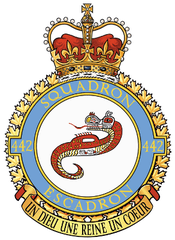442 Transport and Rescue Squadron
| 442 Transport and Rescue Squadron | |
|---|---|
|
442 Squadron badge | |
| Active | 1944-1945, 1946-1964, 1968-present |
| Country | Canada |
| Branch | Royal Canadian Air Force |
| Type | Tactical transport, search and rescue |
| Part of | 19 Wing Comox |
| Motto(s) | Un Dieu, une Reine, un Coeur (English: One God, One Queen, One Heart) |
| Battle honours | Fortress Europe 1944, France and Germany 1944-45, Normandy 1944, Arnhem, Rhine, Aleutians 1943[1] |
| Website | airforce.gc.ca |
| Commanders | |
| Commander | Lieutenant-Colonel Todd Sharp |
| Aircraft flown | |
| Transport | De Havilland Canada CC-115 Buffalo and AgustaWestland CH-149 Cormorant |
442 Transport and Rescue Squadron (French: 442e Escadron de transport et de sauvetage) is a Royal Canadian Air Force tactical transport and search and rescue unit based at Canadian Forces Base (CFB) Comox in the Canadian province of British Columbia. The squadron flies six De Havilland Canada CC-115 Buffalo STOL aircraft and five AgustaWestland CH-149 Cormorant rescue helicopters. One of each is on constant readiness to deploy in response to distress calls in the Victoria Search and Rescue Region, which includes most of British Columbia and the territory of Yukon as well as 560,000 square kilometres in the Pacific Ocean, up to 600 nm offshore. The squadron also serves as the Operational Training Unit for the Cormorant helicopter.
History
The unit was first activated in 1942 flying Curtis Kittyhawks as 14 Fighter Squadron with the RCAF Western Air Command due to the threat to Canada's west coast after the Pearl Harbor attack. The squadron moved to Alaska and participated on strafing and bombing missions against then-Japanese held Kiska during the Aleutian Islands Campaign.[2] The squadron was then renumbered to 442 Fighter Squadron and transferred to England in January 1944 and flew attack and long-range bomber escort sorties in Northwest Europe flying the North American Mustang IV, claiming over 58 enemy aircraft and hundreds of vehicles, locomotives and rail cars.[3] The squadron was disbanded in England in 1945 following the end of hostilities, and reformed a year later at RCAF Station Sea Island as an auxiliary fighter squadron with deHavilland Vampires. Starting in 1956 the Vampires were augmented with the more modern Canadair Sabre 5. However, by 1958 they reequipped with deHavilland Otters and Beech Expeditors flying as a redesignated auxiliary transport squadron.[4] It was again disbanded in 1964 and reformed during the 1968 unification of the Canadian Forces as 442 Communications and Rescue Squadron at CFB Comox before being redesignated to its current name and role a few months later. Since then, 442 Transport and Rescue Squadron has become the busiest search and rescue unit in the country.[5]
- CC-115 Buffalo of 442 Squadron
- 442 Squadron Buffalo 462 in 2004
- 442 Squadron Cormorant 901 in 2008
References
- ↑ Volume 4: Operational Flying Squadrons, Department of National Defence/Directorate of History and Heritage, 19 August 2010
- ↑ Aleutian Campaign, Department of National Defence/Royal Canadian Air Force, 10 December 2008
- ↑ World War II, Department of National Defence/Royal Canadian Air Force, 10 December 2008
- ↑ Post-War, Department of National Defence/Royal Canadian Air Force, 10 December 2008
- ↑ 1960s and beyond, Department of National Defence/Royal Canadian Air Force, 10 December 2008
